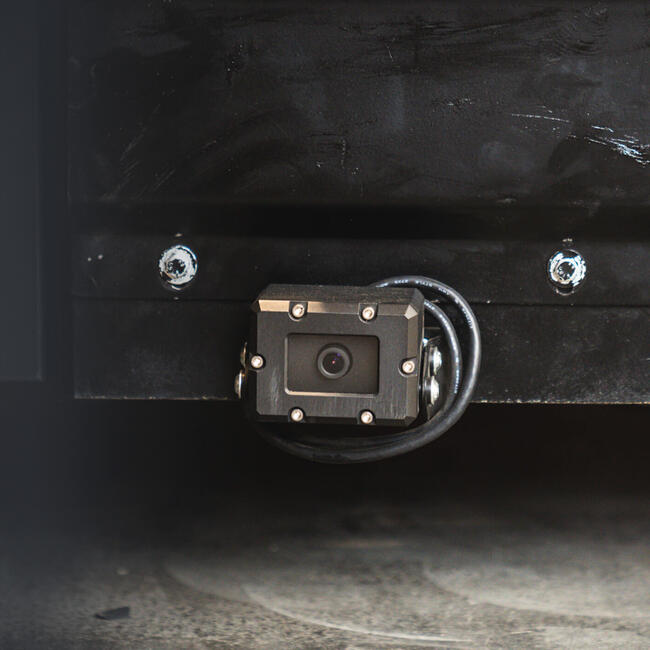As technology advances, camera systems are increasingly becoming standard assistance systems for forklift drivers. They increase safety and improve visibility when maneuvering and storing goods. The driver can carry out his duties faster and more safely. Retrofit forklift cameras are now available for every forklift model.
What are the advantages of camera systems for forklifts?
There are many advantages to a camera fitted as standard or installed retroactively:
- They provide visibility in areas that cannot be seen from the driver's cab or with mirrors.
- Cameras can be combined with other security systems, such as distance warning devices.
- They provide a clear overview during storage and retrieval.
- They prevent injuries incurred by employees in blind spots.
- They prevent damage caused by collisions and maneuvering. They protect forklifts, racks and goods.
- They allow faster and safer handling.
- The driver no longer has to get into uncomfortable positions to see certain zones.
What is the best way to position a camera?
Due to their compact design, cameras can now be installed almost anywhere on the forklift. A multitude of manufacturers offer a wide selection of cameras, displays and accessories, including lights and radio links. These cameras differ in terms of quality, functions, size and price. We generally distinguish between the following types of cameras.
Front view cameras
Provide a clear view of the route when transporting large-volume loads that would otherwise obscure the driver's view. The result is less manoeuvering and damage caused by handling.
Mast cameras
Give the driver a bird's eye view, which is helpful when large loads are preventing a clear view ahead. Since the camera moves with the extendable mast, it is significantly easier to store goods safely and precisely.
Fork carriage and fork cameras
Sit directly on the forks or on the fork carriage. These cameras give the driver a direct view of the loading process and assist the driver in picking up and unloading the transported goods safely and accurately. The driver can check whether the forks are gripping the pallets in the right place, which makes work in high racks in particular much easier.
Reversing cameras
These cameras secure the area behind the forklift. Drivers often have to reverse to manoeuver and are therefore reliant on seeing what is happening behind the truck.
360° cameras
Provide an all-round view of all areas around the truck. Since multidirectional trucks can also drive sideways and diagonally, this type of camera guarantees that the driver has an overview of the entire working area.
Which camera systems does HUBTEX use?
HUBTEX multidirectional trucks can be fitted with a variety of camera models in different positions. The best combination is selected for each application. Forklifts that come without a camera system can also be retrofitted with appropriate systems.
The following models and positions are available:
- Color video camera, industrial design
- Wide-angle lens mounted on the fork carriage (SI mast)
- Wide-angle lens mounted on the mast (DI and TI mast)
- Wide-angle lens mounted on the device
- Wide-angle lens mounted on the right fork (stem height + 250 mm, fork width + 40 mm)
Connection to the display/terminal
In order for the camera image to reach the driver, there are various ways in which the video images can be transmitted to the displays in the driver's cab.
Wi-Fi system
The camera image is transmitted to the terminal via a Wi-Fi transmitter.
Radio system
A radio link is set up between the camera and the monitor using a transmitter and a receiver.
Wired
The camera and monitor are connected by a cable.
Integrated radio system
The camera transmits directly via an integrated transmitter and the corresponding receiver is located in the display.
HUBTEX system
Optionally, the camera can be displayed via the HUBTEX HIT. A second screen is not necessary since all important information is shown on the HIT display. It is then possible to show several cameras on the display at the same time (split screen) or to switch back and forth between the individual cameras. The monitor can be split between 3 or more cameras.
Forklift cameras – robust and suitable for industrial use
Cameras for forklift trucks are no ordinary cameras, they have to meet the special requirements of your application.
They are therefore:
- Resistant to impacts
- Protected against mechanical influences
- Resistant to chemical influences
- Water-resistant to rain and to cleaning with a high-pressure cleaner
- Functional over a wide range of temperatures – from cold stores to foundries

